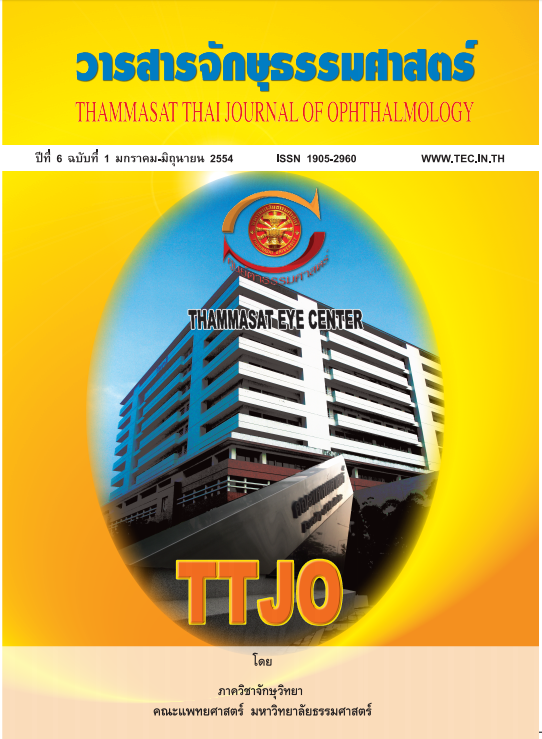การบาดเจ็บทางตาจากกับระเบิดตามแนวชายแดนไทย-พม่า จังหวัดตาก ระหว่างปี 2550-2553
Main Article Content
Abstract
วัตถุประสงค์: เพื่อศึกษาลักษณะการบาดเจ็บต่อดวงตา ของผู้ป่วยตามแนวชายแดนไทย-พม่าที่ได้รับบาดเจ็บ จากกับระเบิดและเข้ารับการรักษาในโรงพยาบาลแม่สอด ระหว่างปี พ.ศ. 2550-2553
วิธีการศึกษา: ศึกษาข้อมูลย้อนหลัง (retrospective study) ในเวชระเบียนผู้ป่วยที่รับการวินิจฉัยว่าบาดเจ็บจากกับ ระเบิดและเข้ารับการรักษาในโรงพยาบาลแม่สอด ตั้งแต่ เดือนมกราคม 2550 ถึงเดือนกันยายน 2553 โดยแบ่ง ผู้ป่วยเป็น 3 กลุ่มคือ กลุ่มที่ 1 มีแต่บาดแผลทั่วไป ไม่มีตาบาดเจ็บ, กลุ่มที่ 2 มีตาบาดเจ็บเพียงอย่างเดียว, กลุ่มที่ 3 มีบาดแผลทั่วไปร่วมกับมีตาบาดเจ็บ ผู้ป่วย ในกลุ่มที่ 2 และ 3 จำนวน 37 ราย มีตาบาดเจ็บทั้งหมด 59 ตา ได้ รับการบันทึกข้อมูลทั่วไปลักษณะการบาดเจ็บทางตา การผ่าตัดรักษา ระยะเวลาในการนอนโรงพยาบาล ระดับการมองเห็นหลังการรักษา โดยนำเสนอผลการศึกษา เป็นจำนวนและค่าร้อยละ
ผลการศึกษา: ผู้ป่วยได้รับบาดเจ็บจากกับระเบิดจำนวน 269 ราย มีตาบาดเจ็บจำนวน 37 ราย (ร้อยละ13.7) อายุเฉลี่ย 29.8 ปี ผู้ป่วยส่วนใหญ่เป็นเพศชายชาวพม่า อาชีพรับจ้าง ระยะเวลานอนโรงพยาบาลเฉลี่ย 8 วัน ผู้ป่วย 37 คน มีตาบาดเจ็บ 59 ตา (ร้อยละ 79.7 ) ส่วนใหญ่ ตรวจพบ small and multiple FB ใน anterior segment ได้แก่ eyelid FB ร้อยละ 62.7 (37 ตา),corneal FB ร้อยละ 49.2 (29 ตา) การผ่าตัดรักษา ได้แก่ eviscerationร้อยละ 28.8 (17 ตา), repair cornea ร้อยละ 10.2 (6 ตา ), repair sclera ร้อยละ 1.7 (1 ตา), lens aspiration with IOL ร้อยละ 5.1 (3 ตา), intravitreous antibiotic ร้อยละ 5.1(3 ตา) หลังการรักษาพบว่าผู้ป่วยส่วนใหญ่ มีการมองเห็นลดลง โดยร้อยละ 61 ของตาที่บาดเจ็บ มี visual impairment ( category 1-5 ) ร้อยละ 49.2 อยู่ในระดับ blind ( category 3-5 ) และร้อยละ 32.2 อยู่ในระดับ NPL มีเพียงร้อยละ 39 ที่ยังมีสายตาอยู่ใน เกณฑ์ปกติ
สรุป: ผู้ป่วยตาบาดเจ็บจากกับระเบิด ส่วนใหญ่พบบาดแผล จาก multiple FB การผ่าตัดหลักคือ evisceration และ repair cornea หลังการรักษาผู้ป่วยมีโอกาสสูญเสีย การมองเห็นค่อนข้างสูง ดังนั้นเพื่อลดจำนวนผู้บาด เจ็บจำเป็นต้องประสานกับหน่วยงานที่เกี่ยวข้องในการ ให้ความรู้กับประชาชนตามแนวชายแดนทั้งสองฝั่ง เกี่ยวกับอันตรายของกับระเบิดการป้องกันตัว รวมทั้ง การพยาบาลเบื้องต้นและความรวดเร็วในการนำส่งผู้ป่วย
Ocular mine blast injuries along Thai – Myanmar border, Tak, during 2007-2010
Abtract
Purpose: To study the characteristic of ocular injuries, treatment, outcome in the patients along the Thai- Burma border who had been injured from landmines.
Material and methods: It is a retrospective and analytical study of patients who sustained mine blast injuries from January 2007-September 2010. The patients were devided into 3 groups on the basis of their injuries. Group 1 required only general surgical attention. Group 2 sustained only ocular injuries, while group 3 had combined ocular and general injuries. 37 patients of group 2 and 3 had 59 eyes injuries. They were reviewed and analyzed. Data included general data, characteristic of ocular injuries, treatment and outcome.
Results: 37 out of 269 patients who sustained mine blast injuries had ocular trauma (13.7%). Average age was 29.8 years old. Most patient were male, Burmese. Duration of hospitalization averaged 8 days. A total of 59 eyes of 37 patients (79.7%) had been damage. Most of them had small and multiple FB in anterior segment. There were eyelid FB (62.7%, 37 eyes), corneal FB (49.2%29 eyes). The surgical treatments were performed to evisceration (28.8%,17 eyes), repair cornea (10.2%,6 eyes), repair sclera (1.7%,1 eye), lens aspiration with IOL (5.1%,3 eyes), Intravitreous antibiotic (5.1%,3 eyes). After treatment, most of patients had decrease vision. 61% of eye injuries had visual impairment (category 1-5), 49.2% were blind (category 3-5) and 32.2% are NPL level. Only 32.2% were still in normal level.
Conclusion: Most of the patients had multiple FB in anterior segment. The major surgery were evisceration and repair cornea. The prevalence of blindness quite high. Therefore, to reduce the numbers of victims need to coordinate with relevant agencies. In order to educate the people along the border on both site about the dangers of landmines, protection, primary care and speed in referral of patients.
Article Details
References
เฉลิมพงษ์ เสริมเกียรติพงศ์. ระบาดวิทยาของการบาดเจ็บจากระเบิด โรงพยาบาลแม่สอด จังหวัดตากระหว่างปี 2542-2547. สวรรค์ประชารักษ์เวชสาร 2548;3:227-39.
Bajec J, Gang RK, Lari AR, Post gulf war explosive injuries in liberated Kuwait. Injury 1993;24:517-20.
Duocet I. The coward’s war. Landmines and civilians. Medicine and War 1993;9:304-16.
Coupland RM, Korver A, Injuries from antipersonnel mines the experience of the International Committee of the Red Cross. BMJ 1991;303:1509-12.
Jackson H. Severe ocular trauma due to landmines and other weapons in Cambodia.Commun eye health 1997;10:37-9.
Waqar muzffar, Muhammad Dawood Khan, M K Akbar, Mohammad Daud Khan,Abdul Majeed Malik, Omar M Durrani. Mine blast injuries: ocular and social aspects. Br j Ophthalmol 2000;84: 626-30.
Mieler WF, Nanda SN, wolf MD, et al. Golf related ocular injuries. Arch Ophthalmol 1995;113 :1410-3.
Zerihun N. Blast injuries of the eye. Tropical Doctor 1993;23:76-8.
World Health Organisation. International stastical classification of disease and related health problems. Tenth revision. Geneva: WHO, 1992.


